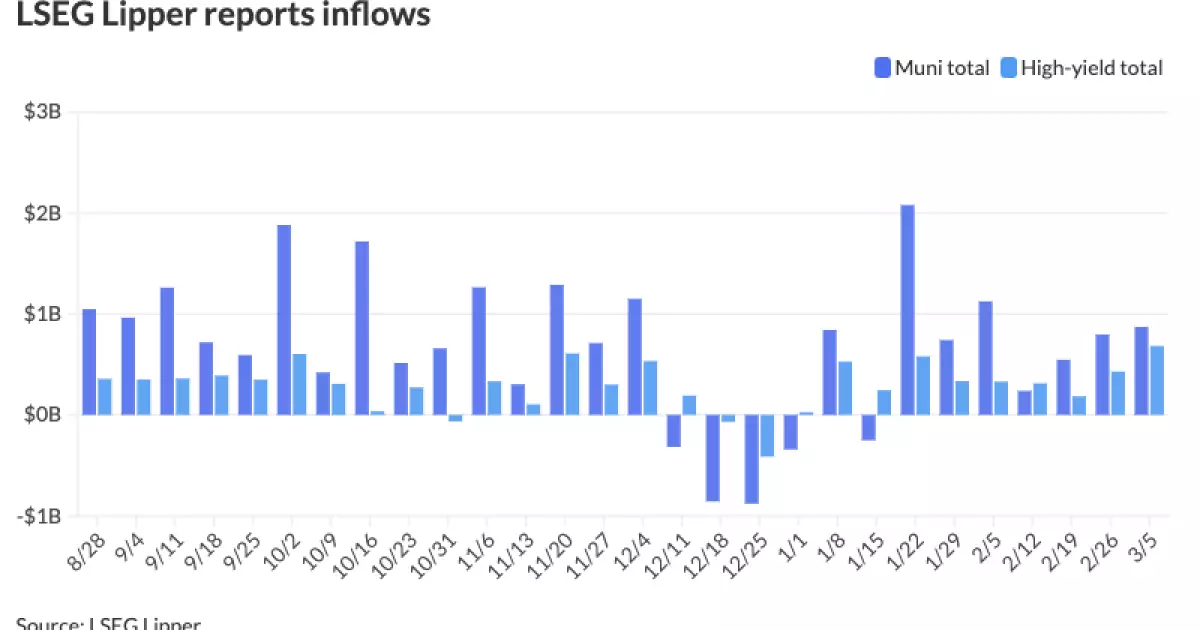In a time of significant economic uncertainty, municipal bonds are showing signs of weakness, reflecting broader trends that could spell trouble for investors. With recent reports indicating a rise in municipal yields by as much as nine basis points, it’s evident that the market is grappling not only with local financial pressures but also with national fiscal policies. The reverberations from Washington, including tariff policies and varied regulations, are creeping into municipal markets, creating a mix of confusion and caution among investors. Cooper Howard, a fixed-income strategist at Charles Schwab, succinctly notes that the market has become a breeding ground for uncertainty—something that is always alarming but particularly so today.
Despite the volatility, James Pruskowski, chief investment officer at 16Rock Asset Management, provides a glimmer of hope, suggesting that this environment will ultimately give rise to more favorable trading setups in the long run. However, the prevailing atmosphere, characterized by thin liquidity and sidelined buyers, leads to a tough pill to swallow: the recovery may not be as imminent as some would wish. The concern here is palpable; when investment avenues become erratic, the stakes get higher, and the odds of making ill-fated decisions rise correspondingly.
The Tax Dilemma and Historical Precedents
March has typically proven to be a challenging month for municipal bonds, with historical data suggesting dismal returns—an average of only 0.03% for this month since 1980, the lowest of any month. As wealthy investors prepare for tax obligations, many opt to sell in March, which adds unnecessary pressure to an already struggling market. Howard’s observations underscore this cyclical trend, where investor decisions are often driven as much by emotional hurdles as they are by data-driven insights. The timing couldn’t be more precarious; we must ask ourselves whether we are witnessing the effects of seasonal cycles or are faced with deeper, systemic issues.
While it remains true that the absolute yields for munis still appear attractive—particularly for high-tax state investors—the overall environment is less than reassuring. Reports showing that over 70% of issuers in the Bloomberg muni index maintain strong ratings may provide some sense of security, yet one would be remiss not to acknowledge that “weaker credits will stay under pressure,” as Pruskowski warns. Investors could find themselves entangled in a web of challenges if they fail to heed this cautionary message.
Inflows and Outflows: Understanding Market Sentiment
Despite a reported influx of $872.2 million into municipal bond mutual funds, juxtaposed with $1.5 billion in outflows from tax-exempt money market funds, the dichotomy in investor sentiment is hard to ignore. For many in the financial arena, the municipal bond market still harbors opportunities, especially given how high-yield funds have fared. Yet the elevated level of caution surrounding the supply can’t be understated. As Pruskowski elucidates, the market is now pricing policy risk with impressive precision, spotlighting segments such as GARVEE and federal lease-backed bonds as potential winners.
One must then confront the distressing reality that this same market can readily turn against investors if they find themselves on the wrong side of a strategic decision. While inflows may suggest optimism, they also highlight a volatile playing field fraught with the potential for rapid decline. The fluctuations in the two-year municipal to UST ratios reveal how significantly the bond market is currently responding to external pressures, such as regulatory changes and evolving economic forecasts.
Future Outlook: Navigating the Unknowns
As we look toward future developments, it’s critical to weigh all factors affecting municipal bonds carefully. With the looming uncertainty and historical challenges presented by this time of year, investors must adopt a more proactive stance. The alertness to softer credits and maintaining vigilance regarding policy shifts will be crucial for achieving favorable outcomes. Beyond this, as new instruments like the Macquarie National High-Yield Municipal Bond ETF gear up to enter the market, a fresh landscape seems poised to unfold.
While proactive investments can shield against downside risks, the structures of financial markets demonstrate that quick shifts can lead to missed opportunities or busted strategies. A nuanced understanding of where we stand today—between potential benefits and profound risks—will serve as the compass guiding investors through these turbulent waters. The key takeaway from this examination is clear: in a landscape riddled with uncertainties and marked by pronounced risk, navigating the landscape of municipal bonds demands both astuteness and strategy.

